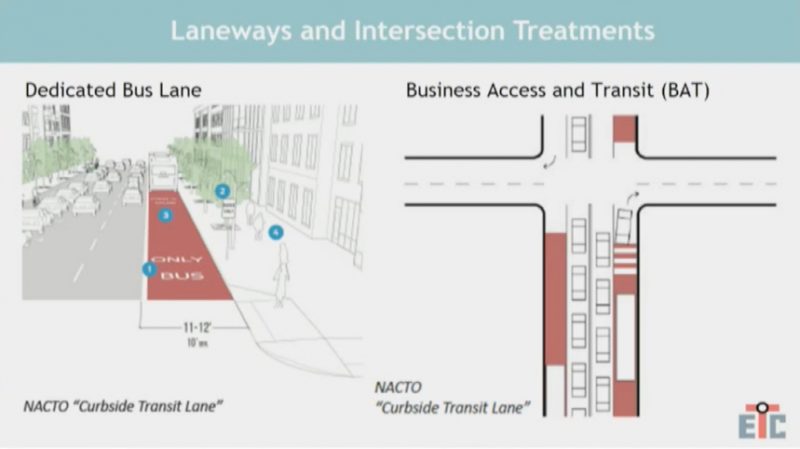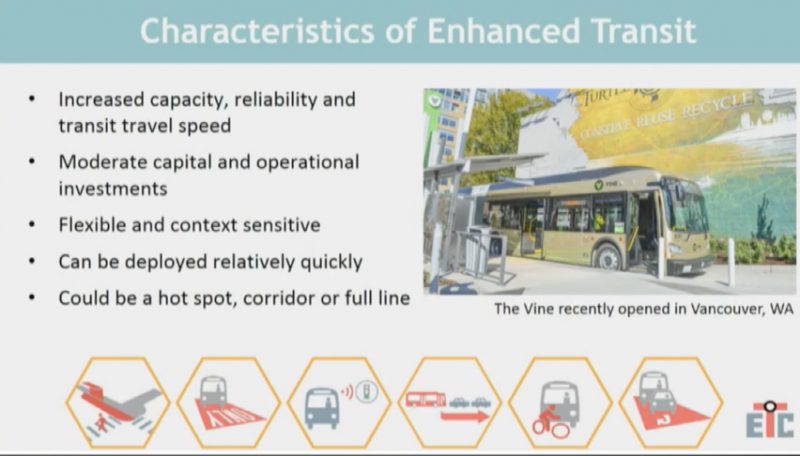
While Portland Mayor Ted Wheeler and his four commissioner colleagues try to justify plans to spend half a billion to widen I-5 through the Rose Quarter in an attempt to “fix congestion”, staff at the Portland Bureau of Transportation are looking at a much more sensible approach. They want to make buses work better.
With the boom in Portland’s population, people are starting to notice that one of the big losers are buses that share the same lane as private automobile users. Mass transit doesn’t work well when it must share the road with private transit. It’s that realization that spurred creation of the new Portland Bus Lane Project activist group this past spring. And it turns out PBOT has been thinking along the same lines.
The city’s Enhanced Transit Corridors plan is ramping up and the first public open house is tonight from 5:00 to 7:00 pm at Metro HQ (600 NE Grand Ave).
The goals of this plan (below) and the projects PBOT wants to build once it’s done are very encouraging — especially in the context of the state transportation package which often feels like it’s mired in a 1960s auto-centric perspective:
Why this plan:
– We need to do more to support transit in Portland.
– Buses are a “work horse.” Some bus lines carry as many riders as MAX and Streetcar lines.
– Data shows that buses are getting stuck in traffic and trips take longer.
– New growth is happening in areas in need of better transit service and access.
– However, ridership is not growing adequately to support growth and the City’s policy goals.
– We have limited sources of revenue. We need to identify priorities on where to start.
Here are a few slides from a recent PBOT presentation:
Advertisement
PBOT defines enhanced transit as something in the middle of the transit spectrum that sits between a regional bus line on one side, and light rail and other forms of high capcacity transit on the other. In a presentation to the Portland Planning and Sustainability Commission about this plan last week, PBOT’s April Bertelsen said (in a nod to our housing policy debates), “While we’re figuring out what ‘middle housing’ is, we’re also figuring out what middle transit is.”
Based on a toolkit PBOT has already developed, “middle transit” is like a high-powered bus line that stops short of being the type of full-fledged bus rapid transit (BRT) systems we see in places like China and Colombia. Their enhanced transit corridors will have things like bus-only lanes, traffic signal priority, fewer and more efficient stops, better bikeway integration and more.
Working with TriMet data, PBOT has already identified several corridors they’d like to move forward with. They want to gain funding to plan for changes to line 72 (between Killingsworth and 82nd), 12 (NE Sandy Blvd), and (MLK Jr. Blvd to Jantzen Beach). The idea is to get a list of projects into the City’s Transporation System Plan and Metro’s Regional Transportation Plan.
If this “enhanced transit” becomes a real thing — the impact to the bicycling environment could be profound. With better transit we’ll see fewer cars which leads to safer roads, stronger community connections, more efficient mobility for everyone, cleaner air, and more bicycling and walking.
PBOT needs your ideas and feedback on their work so far. They hope to bring an initial recommendation to city council on July 13th and have the plan completed by winter 2018.
Learn more at tonight’s open house and check out the city’s website for all the details.
— Jonathan Maus: (503) 706-8804, @jonathan_maus on Twitter and jonathan@bikeportland.org
BikePortland is supported by the community (that means you!). Please become a subscriber or make a donation today.




